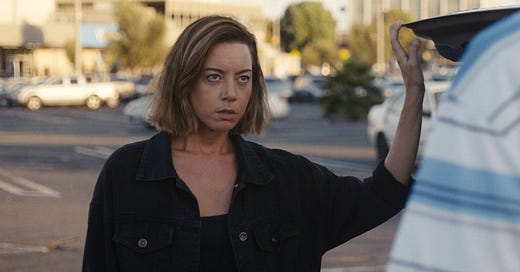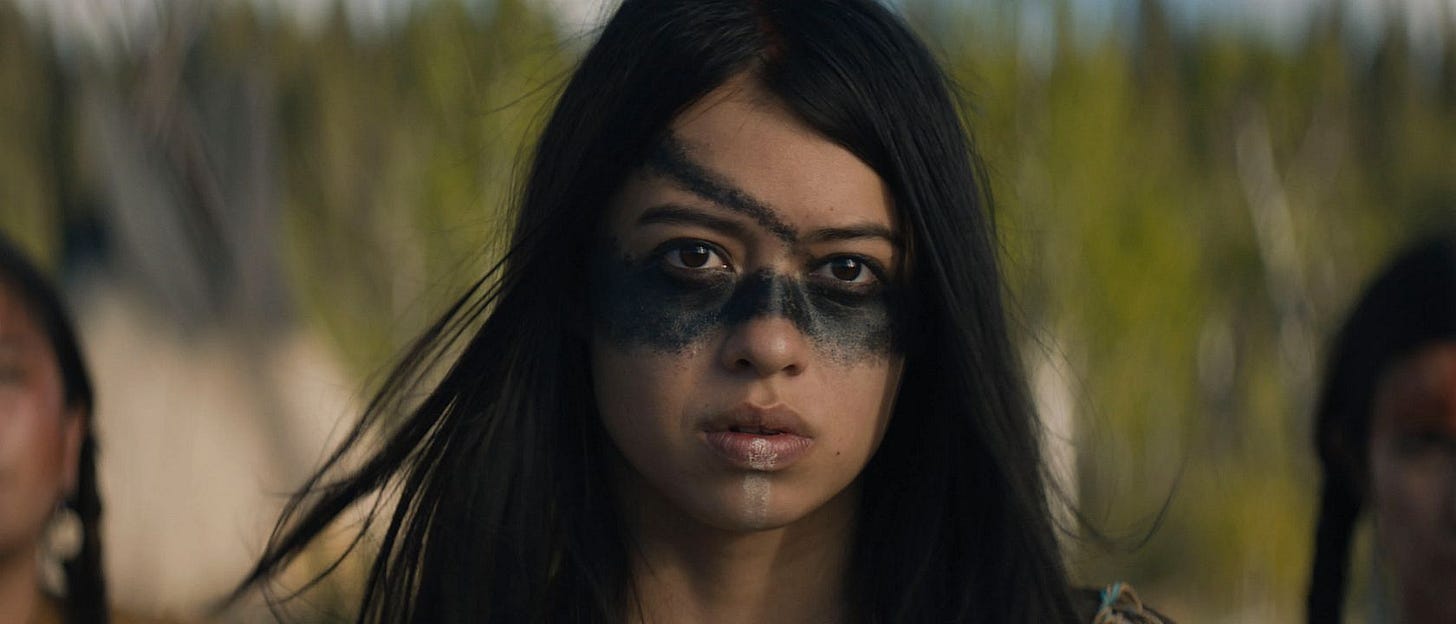Weekend Watch: The Ladies Who Lunge
"Prey" and "The Princess" on VOD, "Emily the Criminal" and "Mack & Rita" in theaters
Catching up with a streaming premiere from last week, “Prey” (Hulu, ***1/2 stars out of ****) is a lean, smart, satisfying creature feature – a B-plus movie. It’s the fourth sequel to the 1987 Arnold Schwarzenegger sci-fi action film “Predator” (provided you don’t count the two “Alien vs. Predator” spinoffs, which you shouldn’t), and for my money it’s the best since the original. The essential setup remains the same: Big honking bug-faced extraterrestrial with dreadlocks and advanced weaponry comes to Earth for a little recreational hunting and meets up with a human and/or humans who have to outwit him (her? it?) with strategy and the tools at hand. What makes “Prey” novel is its setting – the Comanche nation of early 18th century America – and its hero, Naru (Amber Midthunder, above), a young woman warrior aching to show her brother Taabe (Dakota Beavers) and his friends that she’s as skilled a hunter as they are. What makes “Prey” good is the economy and forward momentum of its storytelling, building suspense as it introduces further complications – an angry (if obviously digitized) grizzly bear, a band of atavistic French fur trappers – while keeping the focus on the appealing and resourceful Naru.
Midthunder (FX’s “Legion”), Beavers, and the rest of the Indigenous cast are excellent; “Prey” was filmed in part on Stony Nakoda land in Alberta, and while the characters rather jarringly switch from Comanche to English throughout the movie, a subtitled all-Comanche version of the film exists if you root around in the “Details” section of Hulu’s onscreen menu: Look for “Prey (Comanche Dub).” If you’re a fan of the “Predator” series or action-horror in general, this should go to the top of your list. Even if you’re not, Midthunder is something to see – here and in whatever she does next.
Why “Prey” didn’t get a theatrical release is a mystery, especially given the mixed bag of new movies as we head into the dog days of the summer schedule. The cheeky Gen-Z murder comedy “Bodies Bodies Bodies,” which I reviewed last week, goes wide, “I Love My Dad” is still on the big screen but is newly available for VOD rental from Apple, and there’s a literally high-concept action film called “Fall,” about two women climbers stranded atop a radio tower, that I haven’t seen (and based on the trailer, I’m not going to), so take your chances.
I did see “Mack & Rita” (*1/2 stars out of ****), a new comedy about a young woman (Elizabeth Lail) who wakes up in the body of her older self (Diane Keaton), and I regret to report that it’s an embarrassment all around, despite the talent involved: Keaton, actress-turned-director Katie Aselton, supporting players Taylour Paige (“Zola”), Simon Rex (“Red Rocket”), and the venerable Lois Smith. It’s sad that a script this limply formulaic is the only project on offer for a legend like Keaton, but the actress does herself no favors by shrieking through her scenes, including a slapstick encounter with a Pilates machine that may be a career nadir. Proceed only if you’re a die-hard fan, and only then with low expectations and an Amy Schumer-sized glass of Chardonnay.
Also in theaters, “Emily the Criminal” (*** stars out of ****) is the latest film to feature my favorite dark cloud of an actress, Aubrey Plaza (above). Plaza came to fame as the dour April Ludgate on TV’s “Parks and Recreation,” but her film career has been steadily increasing in adventurousness and daring, from 2012’s wonderful “Safety Not Guaranteed” (bilious Millennial falls in love with a possibly delusional time-travel enthusiast) through 2017’s “Ingrid Goes West” (emotionally unstable woman is desperate for Internet fame) to 2020’s “Black Bear” (a two-part narrative about filmmakers that’s the cinematic equivalent of that M.C. Escher print of two hands drawing each other). “Emily the Criminal” keeps the streak going with its tale of a disaffected Los Angeles woman who can’t pay off her college loans and so joins up with a credit-card-fraud ring run by two immigrant cousins, one sweet (Theo Rossi) and one scary (Jonathan Avigdori). To her surprise and theirs, Emily turns out to be extremely good at criming. Writer-director John Patton Ford has made a slick, engrossing debut feature that isn’t quite as insightful as it seems to think it is but still stings on the strength of Plaza’s fearlessly charismatic negative energy and the script’s glib but inarguable critique of late-stage capitalism.
On HBO Max starting tomorrow (8/13), “The Princess” (*** stars out of ****) a documentary that takes a striking media-studies approach to the life of Diana, Princess of Wales. Director Ed Perkins eschews narration and talking-head interviews in favor of an artfully edited collage of archival news footage, from the first rumors of Diana’s engagement to Prince Charles to the last funeral bouquet laid at the gates of Windsor Palace sixteen years later. This bricolage approach is addictively watchable – even if you don’t need to hear one more thing about Diana Spencer, it’s nice to have the story told in a compact hour and 48 minutes – but it also allows Perkins to build a brutal case against the press and the paparazzi and celebrity culture and the Windsors and the public using their own footage and statements. (The only editorial commentary comes in the form of a beautiful if overly teary score by Martin Phipps.) The film starts with a reporter hounding the 19-year-old Diana down the street and ends with outpourings of mass grief following her 1997 death in a car crash as she was fleeing from cameramen; in between is wave after wave of assaultive attention, and we watch almost in time lapse as the soft-focus girl of the early 80s is attenuated to a bulimic husk and then hardened, in the years following the couple’s 1992 separation, into a steely figure of exhaustion and resolve.
“The Princess” (not to be confused with the fairy-tale action film of the same title currently playing on Hulu) charts the whiplash judgments of the British tabloids, pundits, and people: Diana was adored, then hated, then sympathized with, then reviled, sometimes all in the same week. Perkins’ thesis is not just that fame is hell but that fame on the rarified level that his subject experienced it is a kind of daily living death. What the film never solves is who Diana Spencer may have been to herself. To the royal family she was a womb, to the media she was money, and to the public she was an empty doll into which they could pour whatever fantasies or resentments one carries about the fairy-tale figures we wish were real and destroy when they are. But the person as a person is hardly glimpsed, and in truth this is the wrong place to seek her. “The Princess” would make a fascinating double bill with last year’s “Spencer,” which hazards an emotionally throbbing guess at what daily death looks like from the perspective of the woman trying to live through it.
Quick hits: "“Secret Headquarters” (** stars out of ****) is a Paramount+ premiere that stars Owen Wilson as a goofball dad who’s actually a costumed crimefighter and Walker Scobell as his middle-school son who, with his pals, discovers dad’s basement Batcave and joins in the battle against a tech-bro villain (Michael Peña). It’s lighthearted, formulaic, and cute — your kids will like it and you can look up from the book you’re reading during the dialogue scenes.
If you get Turner Classic Movies as part of your cable subscription, you can watch selected classics on demand via the “WatchTCM” website; the pickings are excellent if random. Currently the channel’s offering a Greta Garbo VOD festival that includes not only the sound-film warhorses (“Queen Christina,” “Ninotchka,” “Camille”) but a healthy selection of her MGM silents. The discovery here is 1928’s “The Mysterious Lady” (***1/2 stars out of ****), a spy-who-loved-me romantic drama that casts Garbo as a Russian undercover agent and Conrad Nagel as a Viennese officer who should know better. The plot’s creaky, but the stars are absurdly hot, especially in the film’s swooning first act. Check it out if you want to experience the Garbo mystique in its early iteration or see how luxuriantly erotic silent films could get.
If you enjoyed this edition of Ty Burr’s Watch List, please feel free to share it with friends.
If you’re not a paying subscriber and would like to sign up for additional postings and to join the discussions, here’s how:
If you’re already a paying subscriber, I thank you for your generous support.





